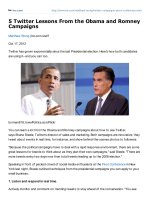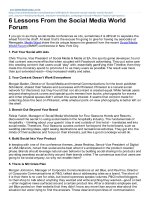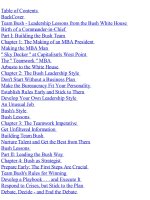Why Organizations Thrive Lessons from the Front Lines for Nonprofit Executive Directors ppt
Bạn đang xem bản rút gọn của tài liệu. Xem và tải ngay bản đầy đủ của tài liệu tại đây (176.45 KB, 48 trang )
Why Organizations Thrive
Lessons from the Front Lines for Nonprofit Executive Directors
By Jonathan Poisner
Smashwords Edition
Copyright 2013 Jonathan Poisner
Smashwords Edition License Notes
Thank you for downloading this free Ebook. You are welcome to share it with your
friends. This book may be reproduced, copied, and distributed for non-commercial
purposes, provided the book remains in its complete original form.
Table of Contents
Introduction
How to use this book
About the author
Lesson 1: Relentlessly focus on relationships
Lesson 2: Communicate excessively with your board
Lesson 3: Transform your organization through one-on-one meetings
Lesson 4: Embrace your role in the network
Lesson 5: Long-term and short-term planning are both essential
Lesson 6: Pick some aspect of your program and get exceptionally good at it
Lesson 7: Synergize
Lesson 8: Evaluate, evaluate, evaluate
Lesson 9: Excel at personnel management
Lesson 10: Build a fiscal management system that connects to strategic decision-
making
Lesson 11: Invest in a great contact management system
Lesson 12: Manage one big institutional change at a time
Lesson 13: Know and tell your stories
Lesson 14: Become a very good public speaker
Lesson 15: Give away your power
Acknowledgements
Introduction
On January 2, 1997, I showed up for my first day of work as the Executive Director of
the Oregon League of Conservation Voters (Oregon LCV).
The Board shouldn’t have hired me.
I was only 30. I had zero fundraising experience, virtually no personnel supervision
experience, and had only been involved previously with one other nonprofit
organization.
A few weeks into the job, I had the good fortune of attending a four-day boot camp
designed for nonprofit Executive Directors. The boot camp was very valuable –
almost a lifesaver as I struggled to learn new skills. The boot camp covered
traditional areas of responsibility for an Executive Director, such as fundraising,
financial management, personnel management, strategic planning, and board
development.
But even with its value, there was something missing from that boot camp and from
other nonprofit trainings I attended over the years.
What I rarely encountered was training that identified the patterns of behavior that
separate Executive Directors who make their organizations thrive from those that
merely do well.
Of course, part of what separates thriving nonprofits from others will always be
better performance at the discrete skills that go into being an Executive Director. All
things being equal, the better fundraiser will raise more money. More money allows
organizations to do more good.
But in my own experience over a dozen years as Oregon LCV Executive Director, and
in collaborating with, volunteering with, and consulting for dozens of nonprofits, I’ve
come away convinced it’s not primarily about the skill set.
It’s about how those skills are applied, with what emphasis, and with what mind-set.
Ever since I launched my organizational development consulting practice in late 2009,
I’ve been working to encapsulate my thinking into a series of Lessons that any new or
newish Executive Director would benefit from learning. Together, these Lessons
attempt to give an Executive Director a path by which they can transform their
discrete skills into effective leadership.
In the end, this is the book I wish I’d been able to read in my first year as an
Executive Director. Or my third. Or my fifth for that matter.
Of course, the book has clear value as well for board members thinking about their
role overseeing an Executive Director and for nonprofit staff who’re contemplating a
future as an Executive Director.
How to use this book
This Book’s fifteen Lessons are based on my observations of both organizations that
have thrived and those that have gone astray, and the more common group in the
middle that muddle through doing good, but not great.
Of course, my observations aren’t based on statistically valid experiments.
The book is intentionally short so that it can be read in a single sitting. My suggestion
is to read it, let the concepts marinate in your mind, and then re-read it again
perhaps a month later. At that point, I’d consider writing down a half-dozen things
you should do differently in reaction to the book.
If possible, it would be even more valuable to find three or four other Executive
Directors with whom to discuss it, either immediately or after thinking about it.
Several reviewers of an early draft of this book asked about the priority order of the
Lessons, in some cases presuming that Lessons presented earlier must be higher
priority.
In reality, I am reluctant to declare any one of these lessons as most or least
important. Instead, I present the Lessons thematically.
Relationships are at the heart of managing a nonprofit organization. You should
relentlessly focus on relationships (Lesson 1). But not all relationships are equal. In
particular, you should place extreme emphasis on your board by communicating
excessively with them (Lesson 2)
You should transform your organization by developing relationships through one-on-
one meetings (Lesson 3). Relationships are particularly important as you embrace
your role in the network (Lesson 4).
In this book, I use the word “strategy” as a catch-all term for deciding what it is your
organization does. Good strategy requires you to equally emphasize both long-term
and short-term planning (Lesson 5). In deciding what to do, you should pick some
aspect of your program and get exceptionally good at it (Lesson 6). You should make
sure your various efforts are synergistic (Lesson 7). No strategic thinking can be
optimal unless you also evaluate, evaluate, evaluate (Lesson 8).
In managing organizational nuts & bolts, you should excel at personnel management
(Lesson 9). You should build a fiscal management system that connects to strategic
decision-making (Lesson 10). You should invest in a great contact management
system (Lesson 11). You should also manage one significant institutional change at a
time (Lesson 12).
Superb communications are also critical. That means knowing and telling your stories
(Lesson 13) and becoming a very good public speaker (Lesson 14).
Lastly, I close with an overall lesson I call: Giving away your power (Lesson 15).
About the a uthor
Since 2009, Jonathan Poisner has worked as an independent meeting facilitator and
organizational development consultant, with a focus on fundraising, strategic
planning, coalition building, and communications for mission-driven organizations. In
the last 3 years, Poisner has worked with more than 45 clients in the Pacific
Northwest and around the country, ranging from small volunteer organizations to
large organizations with a national scope.
In 1997, Poisner became Executive Director of the Oregon League of Conservation
Voters and its sister organization, OLCV Education Fund. During his twelve years
leading OLCV, he grew the combined revenue of OLCV and OLCV Education Fund from
$200,000 to $1.1 million per year.
During his tenure, OLCV’s staff grew from just one and a half full time employees to
more than 11, while dramatically increasing its capacity to involve thousands of
volunteers in its work. Under his leadership, OLCV's electoral program defeated more
than a dozen anti-environment elected officials and helped elect many more
environmental champions to office.
Also during his tenure, OLCV spearheaded the conversion of the Oregon Conservation
Network from a loose collaboration of environmental groups playing defense to a
strong coalition that brings forward shared priorities to the Oregon Legislature every
session. “Priorities for a Healthy Oregon” has had significant success in passing
legislation to promote renewable energy and energy conservation, to establish a
system for recycling electronic waste, to protect farmland from sprawl, to safeguard
clean water, and to protect marine ecosystems, among other things.
From 1997 through 2007, Poisner served on the board of the Federation of State
Conservation Voter Leagues, where he was a strong voice for launching and growing
other state LCVs around the country. From 2007-2009, Poisner served on the boards
of the League of Conservation Voters and LCV Education Fund. He chaired LCV’s State
Capacity Building Committee, while serving on its Executive and Finance Committees.
Poisner holds dual degrees in Economics and Political Science from the University of
Pennsylvania. He has a J.D. from Boalt Hall School of Law at the Universrity of
California Berkeley.
Prior to his leadership of OLCV, he practiced law as an associate attorney at the law
firm of Arnold & Porter, served as Environmental Law Fellow at Lewis & Clark Law
School, taught as an Adjunct Law Professor, and worked as regional staff for the
Sierra Club during the 1996 election year.
Poisner can be reached via his website: www.poisner.com.
Lesson 1: Relentlessly focus on relationships.
Organizations that thrive relentlessly focus on relationships. This must begin with
the Executive Director and the Executive Director’s relationships.
What do I mean by that?
I mean that successful organizations are constantly expanding their pool of
relationships and strengthening existing relationships. Then they consciously activate
those relationships.
To understand why, it’s helpful to take a giant step back and talk about network
theory and social change. A wide variety of books have come out in the last decade
detailing the various ways in which social change happens via networks of people
connected by relationships. The Tipping Point, by Malcolm Gladwell, is a good
example from this genre.
While people receive information outside of relationships, relationships have a
powerful role in how people react to information.
People listen more to people with whom they have a relationship.
People are more likely to be persuaded by people with whom they have a
relationship.
People take action more when requested from people with whom they have a
relationship.
Of course, the quality of the relationship matters too. The deeper the relationship,
the greater the odds that we will listen to someone, be persuaded by them, or take
action at their request.
As a practical matter, the power of relationships can impact organizations in many
ways. One example related to Executive Directors: An Executive Director may give a
pitch-perfect donation request to John Doe. A board member may give a mediocre
donation request to the same John Doe. If the board member and John Doe are
friends, the mediocre board request is more likely to succeed.
Yet, it would be a mistake to think of relationships as just about fundraising.
Relationships impact an organization’s interaction with volunteers, media, allied
organizations, elected officials, and people the organizations are working to serve.
Any time you’re trying to shape behavior, relationships matter.
So how should an organization systematically expand the number of relationships its
Executive Director and other key leaders have with those that matter?
Here are a few examples of ways I expanded my pool of relationships as an Executive
Director.
* I attended fundraisers for peer-organizations, if possible sitting at the table of
people I didn’t already know well.
* I instigated lunch or coffee with the leaders of current and potentially allied
organizations, particularly those I didn’t already know well.
* I asked board members to invite me to any non-fundraising parties they were
throwing so I could meet more of their friends.
* I asked elected officials for advice, as a way to get to know them.
* I attended conferences more with an aim towards meeting new people during breaks
and social times than out of a desire to tackle the subject matter of the conference
work sessions.
None of this would have worked if I hadn’t been genuinely interested in getting to
know these people. You can’t fake authenticity in building relationships.
Of course, relationship building isn’t just about the Executive Director’s relationships.
In planning programs and fundraising, relationships by everyone on the staff and
board should be front and center. Some Oregon LCV activities, for example, never
made sense as stand-alone activities.
Examples:
* Hosting brown bag lunches to compare notes with allies;
* Volunteer appreciation parties;
* Trainings for members of the community;
* Hosting happy hours;
While they had some value, their primary value was to build relationships that our
staff could subsequently tap into in other ways.
If you’re using this approach, staff should know their role at events like these is to get
to know new people rather than hanging out with existing friends.
There are three other practical implications that follow from relentlessly focusing on
relationships.
First, you need to be systematic in planning for relationship-building and tracking
relationships. As an Executive Director, that means setting specific goals (e.g. 5 per
month) for how many new relationships you want to develop in the most important
categories (e.g. peer Executive Directors, elected officials, potential major donors).
And it means actually using a “database” – whether your donor database or otherwise
– to track relationships.
Second, you need to recognize that not everyone is equal when it comes to
relationships. In The Tipping Point, Malcolm Gladwell writes about three types of
people who play a particular role in social change:
Connectors have an unusually large number of relationships.
Mavens have a strong need and ability to help solve other people’s problems.
Persuaders are particularly likeable and charismatic.
In hiring, in recruiting board members, and in recruiting volunteers, Executive
Directors should keep an eye out for people who fit these descriptions and put an
extra emphasis into developing relationships with them.
Lastly, the organization should think hard about how to maximize the value of
relationships once they are generated.
In my experience, the key step in maximizing the value of relationships isn’t the
initial “ask” you might make of someone (e.g. donate, volunteer, etc.), it’s in having
your relationships tap into their own relationships on your behalf.
As I write this, I have 581 people in my Linked In network. Those 581 people have
127,965 direct LinkedIn connections. Of course, LinkedIn is just being used as an
illustration of a point: the people with whom any individual has relationships open
them up to a vastly larger network of relationships than they can ever tap directly.
Organizations that thrive don’t just systematically build and activate first-order
relationships – they get first-order relationships to tap into a further network. As a
practical matter, thriving organizations tend to turn donors into fundraisers and
volunteers into volunteer recruiters.
How do you make that happen? In the online world it’s seemingly easy – Facebook,
LinkedIn, Twitter, and dozens of other sites are specifically geared to allow people to
spread information and “asks” throughout their social network. But while easy to
spread information and asks, online response rates are abysmal.
The real payoff comes when people spread information or make requests where two-
way communication is happening in real-time – which usually means on the telephone
or face-to-face.
How do you get your first-order relationships to turn around and ask their friends for
donations, to volunteer, to attend an event, to write their Congressman, or just to
talk up your organization when at a cocktail party?
At the simplest level it’s by having a compelling message that motivates them. (More
about this in Lesson 13, Know and Tell Your Stories).
But beyond message, you need to structure their involvement in ways that motivate.
At Oregon LCV, we did this first and foremost by organizing teams of volunteers at the
local level who took ownership of certain organizational decisions, thus motivating
them to act. With their help, we grew from an organization with a few dozen
volunteers in 1996 to more than 1000 by 2004.
Of course, you can have all the relationships in the world, and your organization
won’t thrive without many other elements. But organizations that thrive almost
universally place a very high value on building and strengthening personal
relationships.
Lesson 2: Communicate excessively with your board, but be smart
about it
The most important set of relationships for an Executive Director is with their board.
To maintain and strengthen this relationship, Executive Directors should communicate
excessively with the board, but be smart about it.
I sometimes think of the Executive Director as the conductor and the board as the
orchestra. If they aren’t on the same page, they may still play, but it won’t sound
very good.
One common mistake that new Executive Directors make is failing to recognize the
gap between what they know about the organization and what the board and other
close friends of the organization know.
The Executive Director lives and breathes this stuff. Board members and other key
stakeholders don’t.
Even if a newcomer to the organization, the Executive Director’s organizational
knowledge usually surpasses the board’s in a few months.
And as the knowledge gap grows, dangers abound. When it comes to setting the
organization’s strategic direction, a board and staff that are seriously disconnected
about the basic facts about the organization’s work are far more likely to disagree.
I once spoke with an Executive Director who feared their board’s involvement in
strategic planning. “They don’t understand what we do, so how can they set our
strategy?” Yet, I’d characterize his own communications with his board as
intermittent and scattershot.
So my advice to new Executive Directors is to communicate excessively with their
boards, but be smart about it.
Here are my top eight tips about how to make that happen:
1. Board packets should be complete and get out on time.
Reading is a much more efficient way to convey information than speaking at a board
meeting. Board packets should be thorough and given to board members sufficiently
in advance of a meeting so they can digest it. For most boards, that’s a week.
To use this strategy, though, you must be disciplined in having your board chair create
a culture that board members read packets prior to meetings. The first time your
board chair brushes aside a board members’ question or objection because they
didn’t read the packet, it may create some hard feelings. But I witnessed first-hand
early in my tenure at Oregon LCV how doing this just once in an open way can change
subsequent meetings for the better.
2. Write for them, not you.
To borrow a phrase from a mentor of mine, Joel Bradshaw, you should write your
memos starting where they are, not where you are. Put yourself into the head of a
board member and give them the information they would want to know. That means
staying focused on information relevant to the board’s role, not information that’s
important for staff.
3. Repeat yourself.
Remember that you live this and they don’t. Just because you told the board
something the prior meeting, doesn’t mean they’ll remember it. The average person
must hear something seven times to remember it. If there are key facts, strategies,
or other things you think the board should know, communicate them multiple times in
different ways over the course of a few meetings.
4. Communicate after board meetings with those who didn’t attend.
One of the biggest barriers to a board and Executive Directors staying on the same
page is that board member attendance at board meetings will be inherently uneven.
In nearly thirteen years running Oregon LCV we held approximately 50 board meetings
and, ironically, the only meeting where there was perfect board attendance was the
one where I told them I was leaving.
The danger is that board members who miss meetings aren’t aware of key decisions
and become disconnected from the latest happenings of the organization. Minutes
usually don’t come out quickly and for most organizations the minutes are solely
focused on action items where the board voted.
In my experience, Executive Directors should provide a written update (a short memo)
the day after every board meeting entitled: “What happened at the [Insert Date]
board meeting.” These are not minutes, which should be separately produced by
your board Secretary or other designated board member.
The memo should explicitly state that it was prepared primarily for the benefit of
those who didn’t attend, but everyone is encouraged to read the memo to let the
Executive Director know if they think something that happened at the meeting was
mischaracterized.
The memo structure should lay out the most significant things that took place at the
board meeting, including all the action items, as well as other discussions of
importance. In my experience, it took me about 30 minutes to write a memo like this
covering a 4 hour board meeting.
That 30 minutes was well worth it, both because board members really appreciated it
and it also served as a quick place for me to search back and recall what we had done
and when.
5. Don’t rely just on email.
People are busy and not all emails get read or dealt with – not out of a conscious
choice to ignore you, but rather just from excessive competition from other demands
on their time.
I once spoke with an Executive Director complaining about their board’s lack of
engagement and it became clear that his evidence amounted to: “I emailed them,
and they didn’t respond.”
Pick up the phone and call them. Meet with them in person.
6. Remember it’s about relationships.
Lesson 1 of this Book was: Relentlessly Focus on Relationships.
Nowhere is this as important as it is with board members, particularly your board
chair.
Lesson 2 isn’t “talk” to your board excessively,” the lesson is “communicate” with the
board excessively.
Communication is a two way behavior. You need to talk to them and listen to them,
continually taking their temperature about the organization. This will help you fine-
tune your own communications with them, and help keep the board pointing in the
same direction.
More importantly, it also allows for you to develop an authentic relationship with
them based on mutual respect and shared values. Having a real relationship with
them places you in a far better position to push them to greater levels of leadership
on behalf of the organization. And yes, leadership includes fundraising.
My personal goal as Executive Director was to meet at least once each year with every
board member informally over lunch or coffee for an open-ended chat. I met much
more regularly with the board chair, although those meetings were more focused on
specific topics than open-ended.
And with new board members, I always did an “orientation,” which was as much
about my getting to know them as their getting to know the organization.
7. Be candid when things have gone wrong.
If you or your staff screwed up, own up to it, and be timely about it.
I made a couple significant mistakes at OLCV, both times costing OLCV real money.
For example, after one election, staff and I concluded one of our vendors had failed
to perform services, so I withheld the final $1,500 payment on a $25,000 contract.
The vendor forced us into arbitration and it became a he said, she said situation.
Unfortunately, the arbitrator rules against us, costing us not just the $1,500, but
nearly $8,000 in legal fees. In hindsight, I shouldn’t have taken the risk of fighting
the payment without slam dunk proof that we had been wronged.
Some boards might have freaked, but I think mine appreciated how up front I was
about the situation, what happened, and what lessons we had learned from it.
If board members grow to lack trust that their Executive Director is presenting an
honest picture to them, it’s very hard to move forward.
The opposite situation is learning how to be candid when it’s the board that has made
a mistake. It’s easy to ignore these mistakes since the board, after all, consists of
volunteers. In my experience, though, the better path is to be clear about the
mistake, and let peer pressure be a means to hold board members accountable. If
your board develops a culture where nobody is held accountable, it’s almost always a
challenge to reverse that culture.
8. Quantity of communication isn’t as important as quality.
This is the “be smart about it” part of the lesson.
Burying your board in paper isn’t the same as communicating with them. You can
communicate so many different things that they throw up their hands and tune you
out.
I once read an Executive Director’s yearly report to their board and it was mind-
numbingly detailed, exceedingly dry, and I can’t fathom it was digested by anybody.
When a board member asked a question at a subsequent strategic planning session I
facilitated, the Executive Director’s response was: “that was in my annual report,
haven’t you read it?”
Your board should be thinking about two things predominantly for your organization:
big picture strategy and fiscal health/fundraising. Focus most of your
communications on those areas.
So communicate with them excessively to build the relationship and make sure they
understand key details that effect strategy, but that’s not the same as burying them
in information and trivia.
Lesson 3: Transform y our organization through one-on-one meetings
If relationships are your focus (Lesson 1), then a corollary lesson is to transform your
organization through one-on-one meetings.
While Lesson 1 outlined variou methods to expand your pool of relationships, one-on-
one meetings are so critical they are worth a lesson of their own.
Why are one-on-one meetings so important?
Two things happen in one-on-one conversations that don’t happen at events and
certainly not via mail or phone.
First, you can form a stronger personal relationship. Second, you can most effectively
ask people to take personal responsibility to assist your organization.
Forming a relationship is the more obvious benefit of one-on-one meetings.
It’s not rocket science to understand forming relationships is easier in-person.
Legions of studies have demonstrated the role of body language and facial expressions
in communication – neither of which works over the phone or in writing.
And in one-on-one meetings, you can make the communication truly two-way – asking
questions of a potential organizational supporter and not just talking to them. You
can and should do this in an authentic and not a staged way.
This formation of a personal relationship is half the magic. The other half of the
magic is something I’ve discovered more recently.
When meeting with somebody one-on-one, you are asking them to take personal, and
not collective responsibility.
At an event, it’s about how all these people in the room can help. One-on-one, it’s
about how the individual can help.
Studies done in the 1970s and 1980s focused on personal versus collective
responsibility in a different context. Scientists had people fake epileptic seizures in
public places to see who would help. The interesting finding is that the “victims”
were more likely to get help if they had the seizure when one person was there to
observe than if several people observed.
This is contrary to what most people would predict. But it rings true upon further
reflection. When something unusual happens and other people are around, you tend
to look around to see how they’re responding. If everyone else is just looking around,
you may think: I guess it’s not my problem. But if there’s nobody to look at, you have
no choice but to understand the responsibility is yours.
The same dynamic works with fundraising. Organizations across a wide array of issue
areas, whether local, state, regional, or national, have found that generating truly
large, meaningful donations happens most effectively at one-on-one meetings. For
small organizations, “large and meaningful” might mean $500 or $1,000 donations.
For large national organizations, large and meaningful might mean $100,000
donations.
From 1997-2009, I served on the board of a network whose mission was to launch and
grow state conservation voter organizations. As I talked to Executive Directors of the
new and growing organizations, I noticed a very clear pattern: When I asked them
about how their fundraising was going, Executive Directors from those that were truly
growing fast tended to speak about their one-on-one major donor fundraising, while
those from the organizations that were floundering tended to talk about their
fundraising events.
Of course, meeting with people one-on-one isn’t always about fundraising as
measured by immediate donations. As you get to know people through one-on-one
meetings, you’re in a better position to ask them to get involved in other ways – as
volunteers, as evangelists, as board members, as someone who’ll connect you to their
friends, etc. You will also learn considerably more about the community, as those
you meet with share their own views about the challenges you’re facing and the
strategies you’re using.
So stop putting your time into the next great event and banking on social media
revolutionizing your organization. If you want to thrive — get out and meet with more
people one-on-one and invite them to take responsibility.
Lesson 4: Embrace your role in the network
Organizations that embrace their role in their network are more likely to thrive.
Lesson 1 emphasized the importance of relentlessly focusing on building personal
relationships.
Just as individuals form personal relationships, organizations have connections to
other organizations. If you were to “map” out all these connections into a network,
you would get a glimpse at how an organization interacts with its connections.
Organizations that understand and embrace their role in their network are more likely
to thrive than those who view themselves in isolation.
Why should you embrace your role in the network? And how do you embrace it?
Let’s start with the why question: What benefits flow from embracing your role in
the network?
Margaret Mead was right that a small group of people can change the world.
But they’ve done so by generating movements and being part of them.
Every organization I’ve ever encountered has identified a problem it is addressing that
is bigger than it can address within its planning horizon.
This is true whether your organization has global aspirations (e.g. save the planet) or
a very a narrow niche (e.g. direct mental health services to individuals who can’t
afford them in your local community).
Indeed, we are rarely inspired to build a thriving organization if the problem to be
addressed is an easy one. Yet, how can we then avoid being paralyzed by fear as we
recognize the enormous gap between what we hope to achieve and our current
capacity?
From a staff and volunteer morale perspective, you do this by identifying the unique
role your organization plays as part of a larger network of organizations and people.
Just as people feel pride in being part of an organization, that sense of pride can
grow if they can picture how the organization is playing a role in a broader
movement.
Embracing your role in the network also leads to better strategic choices.
Just as no man is an island, no organization stands alone. In every example I’ve ever
imagined, I can think of many other organizations (nonprofit, for-profit, government)
whose mission, purpose, and work somehow interacts with the organization in
question.
Those interactions can be entirely positive in the form of alliances for a shared
purpose.
Those interactions can be competitive, organizations that somehow fight for the same
resources you need.
Those interactions can also be negative in the form of opposition.
Taking these interactions into account when setting your strategic direction leads to
better strategy.
A really basic example: I recently met with an organization whose mission has very
substantial overlap with another nonprofit. Their response: strategically position
themselves as the “bad cop” to the other organization acting as “good cop” when
advocating to elected officials for policy change.
Conversely, failing to take into account these organizations can lead an organization
astray in setting strategy. I once was on the board of an organization that developed
a brand strategy for their organization without reference to its larger allies, with
whom the organization was also competing for resources.
Rather than developing a brand focused on the organization’s unique role within the
broader set of allies, the branding decision took place as if those allies didn’t exist.
The result was a recommended brand for the organization that blurred the distinction
between it and its allies, making fundraising even harder.
In hindsight, I believe the organization would have been far better off actually talking
with its allies about how its brand could be developed in relationship to its allies,
focusing on the unique role it could play in the network.
Which leads to the second question: How do you embrace the network role?
I think there are two key steps.
First, explicitly make this part of your strategic planning process, as you assess the lay
of the land. Just as you want to figure out what economic, political, demographic or
other trends create the landscape in which your organization plans, you should assess
the organizational landscape.
Ask:
* Who are the major organizations that serve as allies and opponents?
* For allies, what distinguishes our role in addressing shared problems from their
roles?
* How can we best take advantage of the work they’re doing?
*How do we account for the interactions we have with these organizations when
competing to secure resources (e.g. fundraising)?
Of course, identifying your role is only half the challenge. A second critical step is
then building enduring connections to those organizations that positively interact with
your organization.
Organizational connections are fueled first and foremost by personal relationships.
Get to know the leaders of allied organizations by having coffee, lunch, or a drink.
Ideally, find ways to let your boards know each other, not just staff.
Organizational connections are also fueled through more formal coalitions and
partnerships. Be conscious in determining when a coalition of organizations would be
helpful and, if a new one is warranted, launch it. Sometimes, the answer will be a
partnership with a single additional organization rather than a grand coalition.
Bottom line: as you develop both formal connections with other organizations and
lots of personal relationships, your organization will be far better positioned to thrive.
Lesson 5: Long-term and s hort-term planning are both essential
Some organizations have a personality that is frenetic. They are always doing.
Everyone’s very busy. Lots of things are getting done, but many tasks are being
triaged (consciously or by neglect). Long-term investments are not made. And the
left hand, too often, doesn’t know what the right is doing.
At critical junctures, information necessary to move forward is either missing or
inadequate. Time is wasted in meetings discussing next steps. Making positive
change becomes harder. The organization runs like a rat around the wheel, but never
gets the wheel to the next level.
In my experience, these organizations fail to hit the next level because they fail to
recognize the critical importance of both long-term and short-term planning.
Given the fact that my consulting practice focuses significantly on strategic planning,
my belief in the importance of long-term planning shouldn’t surprise the reader.
Working without a strategic plan brings to mind a favorite exchange from Alice’s
Adventures in Wonderland, when she first meets the Cheshire Cat.
Alice: “Would you tell me, please, which way I ought to go from here?”
Cat: “That depends a good deal on where you want to get to,” said the Cat.
“I don’t much care where,” said Alice.
“Then it doesn’t matter which way you go,” said the Cat.
Yet, knowing where you want to go is a far cry from having a well-designed plan to
get there.
Most nonprofit organizations I talk to have a strategic plan, or at least acknowledge
the desire to have one. At its core, strategic planning asks “Who are we? Where are
we going? What should we be doing? How will we do it?” Usually over a longer time
frame, anywhere from 2-5 years.
Different consultants will use different terms (examples include: mission, vision,
values, goals, strategies, objectives). What matters is not so much which terms you
use, but that everyone in your organization uses consistent terms so that you can
communicate internally.
The planning process should include some level of research of both the external
environment (the lay of the land) and internal context (strengths, weaknesses,
evaluation of past work, etc.). It should include some facilitated process to identify
key strategic assumptions and/or a logic model by which to explain why the activities
you’re doing will lead to the goals you’re pursuing. And it should ultimately include
some measurements of success, so you’ll know if you’re making process.
The biggest fear I hear about strategic planning is that plans too often sit on the
shelf, unused.
Three steps come to mind to insure the strategic plan is used.
First, explicitly utilize the strategic plan when doing budgeting. (More on this in
Lesson 10, Build a fiscal management system that connects to strategic decision-
making).
Second, develop a culture of evaluation, a key part of which involves consistently
(e.g. every 6 months or year) re-presenting the strategic plan to the board as part of
evaluating how you’re doing. (More on this in Lesson 5, Evaluate, evaluate,
evaluate).
Lastly, and most importantly, develop yearly work plans by individual and/or function
(e.g. development) that are designed around the strategic plan.
A couple years ago, I was talking with a fellow strategic planning consultant and he
noted that one of the biggest challenges he has experienced is that organizations
(whether for-profit or nonprofit) underestimate the amount of time and energy it
takes to do good strategic planning. Then, when they finish it, they skip or skimp on
short-term work planning, whether out of exhaustion or a backlog of small, urgent
items on their to-do list.
The very next day his point was proven to me: I was talking with the Executive
Director of a client and asked to see their strategic plan and any work plans they had
adopted. She sent me the strategic plan, but told me they were so busy when the
strategic planning process ended that they just dived in and, with the exception of
one staff person, produced no work plans.
This brought to mind one of my favorite sayings – allegedly by The Buddha: “There is
so much to do, you must move very slowly.”
In my mind, planning isn’t just deciding what to do, it’s equally as important deciding
what not to do. When you’re really busy is precisely the time when it’s most
important to stop, plan, and focus like a laser on those activities that are essential in
the short-run given your long-term strategy.
In my experience, groups that carve out the time to adopt yearly work plans for
individuals and/or yearly operational plans for specific programs or functions are far
more likely to thrive than those who don’t.
When individual and operational planning is done, staff members are more likely to
stick to clear timelines. They are more likely to have clarity about roles and
responsibilities. They are less likely to stray into low payoff activities. They are less
likely to burn out. And the Executive Director will have far more information from
which to do a good job evaluating and boosting the performance of staff. (More on
this in Lesson 9, Excel at personnel management).
If this sounds time-consuming to you, that’s true and it’s false. It does take time to
do operational work plans. But in my experience, and from talking to other Executive
Directors, you will save time in the long run. A day spent work planning once a year
can easily save far more time over the year as the Executive Director repeatedly
answer door knocks from a staff person asking: “do you have a minute.”
Of course, yearly work plans won’t eliminate mid-year decisions. But making more of
the big decisions up-front, consciously, thinking through the interaction of decisions,
particularly as they relate to allocation of staff time, is far more likely to lead to a
thriving organization.
So how does an organization adopt a culture that equally prizes both long-term and
short-term planning?
The easy answer is it starts at the top with the Executive Director and board
leadership. The Executive Director must lead by example with his or her own work
planning.
But here are some additional ideas:
When you get ready to do strategic planning and lay out a timeline and budget for the
planning process, don’t let that timeline and budget end with the adoption of the
strategic plan. Incorporate additional staff time to develop work plans either by
function, program, or at the individual staff level.
In years when you’re not doing strategic planning, consider conducting one other
significant planning project. Examples might be: a long-term technology plan, an
organizational communications plan, or a long-term development plan. Plans like
these always take more staff time the first time you create them, so don’t roll out
more than one of these in any given year. If possible, stagger them so that they don’t
expire in the same year.
Reward staff for planning. Evaluate staff performance in part based on whether they
achieve the measurable objective of completing timely and solid work plans around
specific programs and tactics. When one of your staff develops a format and plan
that’s particularly well done, share it with others as an example.
Lastly, don’t let perfection become the enemy of the good. It’s far better to do some
decent planning than to wait for the stars to line up for you to create the perfect
plan. Dive in.
Lesson 6: Pick some aspect of your program and get exceptionally
good at it.
Lesson 5 emphasized the importance of both long-term and short-term planning, but
without regard to the content of the plan: e.g. what to do. Obviously, there’s a
different “what to do” answer for every organization – no two groups are the same
and every group faces a slightly different lay of the land.
In deciding what to do, one of the key observations I’ve made about why some groups
thrive while others don’t is that thriving groups tend to pick one aspect of their work
to which they heavily commit.
No organization can realistically be the best at everything it does. Yet, it’s important
to be the best at something. Of course, it should be something where you can
articulate the strategic rationale for why the activity furthers your mission and it
needs to be something that the staff can feel passionate about.
An example: At Oregon LCV, we made a conscious decision in 1997 (when we were a
small organization with just two people on staff) that we were going to get
exceptionally good at grassroots politics. We were never going to write the largest
checks in Oregon politics. But we would tap into the passion Oregonians have for
their natural legacy by creating the largest and most effective volunteer force in
Oregon politics.
We invested heavily in staff whose primary job was recruiting and managing
volunteers, along with data systems to support them. Our programs were designed to
maximize the number of volunteers we would effectively engage in our election work.
By 2004, we were involving more than 1000 volunteers in our election activities –
generating more than 100,000 contacts with voters that cycle. I couldn’t prove for
sure that Oregon LCV was the largest and most effective grassroots force in Oregon
politics, but I heard repeatedly from outsiders that we were perceived as a real force
to be reckoned with.
Other groups with whom I’ve interacted have done similar things. They sought to and
became exceptional at:
* Bringing people together from different sectors of the economy to work together;
* Mastering the latest communication technologies;
* Using the best possible language to communicate;
* Understanding the legal levers by which to help the people they serve.
With Oregon LCV and with each of these other examples, the organization made a
conscious, strategic choice that they’d be exceptional at the one thing and pursued
that strategy over several years.
Why is this level of hyper-focus useful for a growing organization?
For starters, getting a reputation for being really good at one aspect of your work
carries many institutional benefits.
Most obviously, there are fundraising benefits. At Oregon LCV, I was able to excite
donors to increase their investment by being able to articulate to donors that we
were the best at something connected to fulfilling our mission. It’s not that they
were in love with volunteers as an approach. What excited them was that we were
the best at something, creating the perception that they were investing in a winning
organization that makes a real impact.
I’ve seen more than one example of new organizations that have rejected the “excel
at one thing first” approach and instead launched a wide variety of programs from
their inception. One Executive Director pursuing that approach said they were doing
it to “puff themself up and appear bigger than they we are, so that we can attract
funding.” It didn’t work out that way, as the organization remains at the same level
of funding two years later.
There are also staff morale benefits from becoming exceptional at one thing. Staff at
nonprofits almost always could make more money in the private sector. They take on
your important work because they believe in your mission. The more you can add
intangible benefits to supplement their pay the better. Pride is a great intangible
benefit and being part of a team that’s the best at something is something that
generates pride. (Pride can also help board members be better fundraisers).
Another benefit from an “excel at one thing first” strategy is it helps an organization
stay focused. I’ve watched several groups that have appeared to follow a “we’ll be
the best at everything from the start” approach to their program, the result of which
has invariably been that their program work is mediocre across the board. They don’t
know how to say no to things. Having a plan predicated on first getting really
exceptional at one strategy is a great tool for an Executive Director and board to use
in saying no to the “latest, greatest idea.”
In picking an area in which to be “great,” it’s important to pick something that
matches up with your passions and helps fuel your fundraising. If the Executive
Director in particular can’t feel passionate about the strategy, it probably won’t
work. In Good to Great and the Social Sectors, business author Jim Collins writes
about the hedgehog concept, an organization that knows one thing really well. That
one thing should hit the sweet spot between three things: what it can be the best at,
what it is passionate about, and its resource engine (e.g. fundraising, earned revenue,
etc.). Trying to be the best at something you’re not personally passionate about or
where there is no potential donor-base is a recipe for failure.
Of course, once you’ve established you’re the best at something, you shouldn’t feel
locked into that strategic focus forever. All strategies have a shelf life and should be
reevaluated from time to time. In Oregon, other groups emerged that were also
exceptional at grassroots politics. Partly as a result, Oregon LCV’s strategies evolved.









